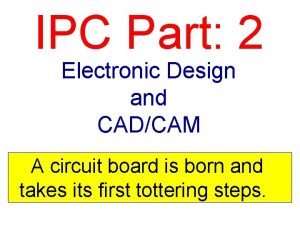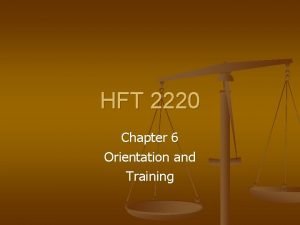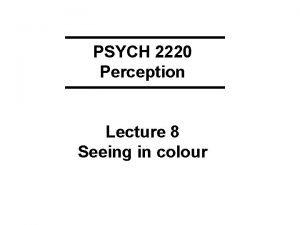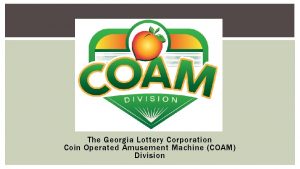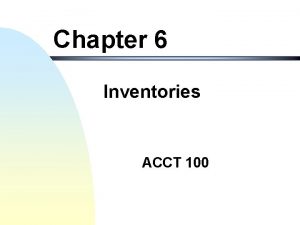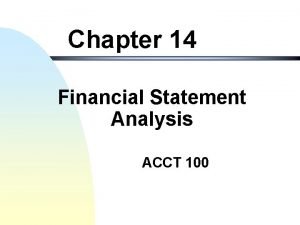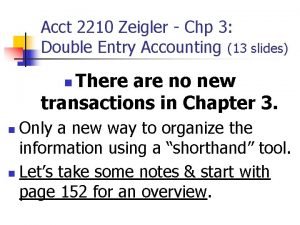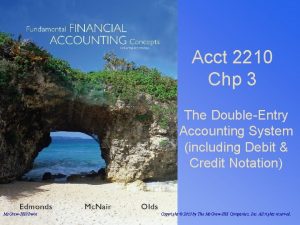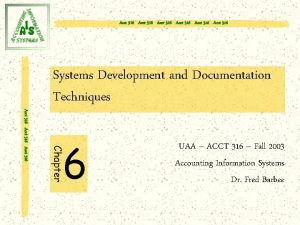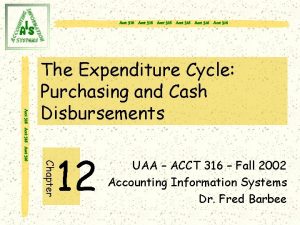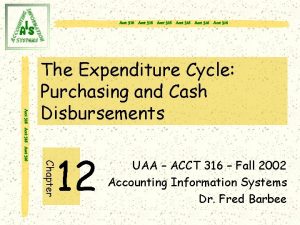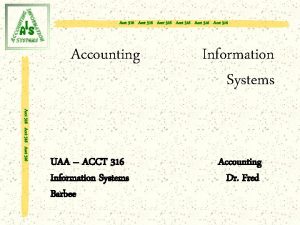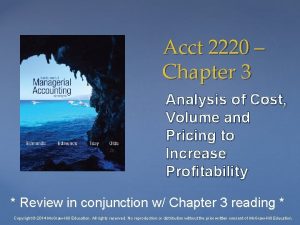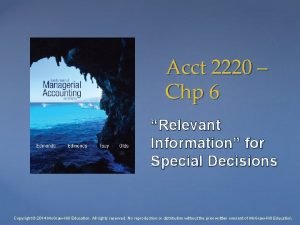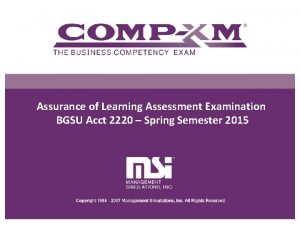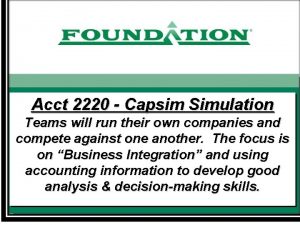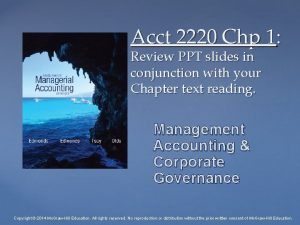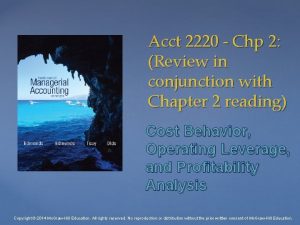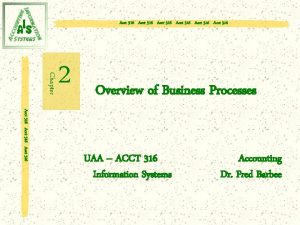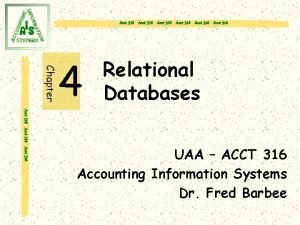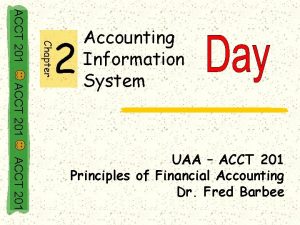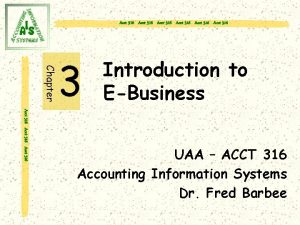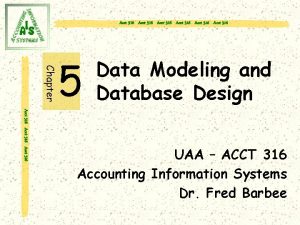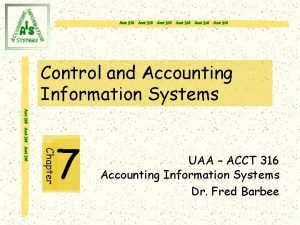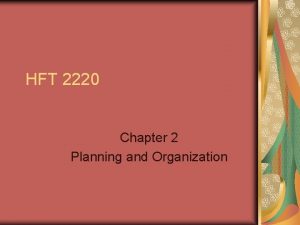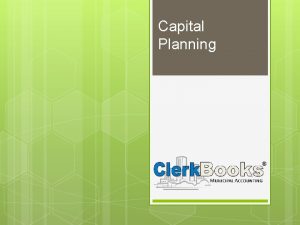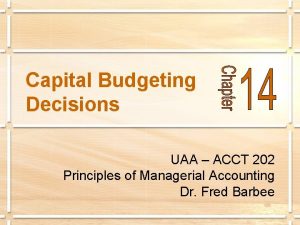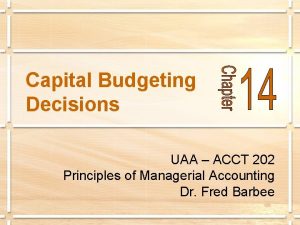Acct 2220 Chapter 10 Planning for Capital i






































- Slides: 38

Acct 2220 Chapter 10 Planning for Capital (i. e. longterm) Investments Copyright © 2014 Mc. Graw-Hill Education. All rights reserved. No reproduction or distribution without the prior written consent of Mc. Graw-Hill Education.

Learning Objective Explain the time value of money concept. LO 1 10 -2

Capital Investment Decisions Purchases of long-term operational assets are capital investments. Once a company purchases operational assets, it is committed to these investments for an extended period of time. Understanding the time value of money concept should help you to make rational capital investment decisions. 10 -3

Time Value of Money This concept recognizes that the value of a dollar received in the future is less than today’s dollar. The further into the future the receipt is expected to occur, the smaller its present value. When a company invests in capital assets, it sacrifices present dollars in exchange for the opportunity to receive future dollars. 10 -4

Minimum Rate of Return Most companies consider the cost of capital to be the minimum expected ”return on investment” (ROI) that must be achieved. Creditors expect interest payments, and in most companies, owners expect dividends and increased stock value. The blend of creditor and owner costs is considered the “cost of capital” for an organization. 10 -5

Converting Future Cash Inflows to Their Equivalent Present Values EZ Rentals wants to add LCD projectors to its product line. If EZ invests $178, 571 on January 1 and requires a rate of return of 12%, the company will expect a $200, 000 cash inflow at the end of the first year. Investment + (0. 12 × Investment) = Future cash inflow 1. 12 (Investment) = $200, 000 Investment = $178, 571 10 -6

Present Value Table for Single. Amount Cash Inflows Table 1 in the Appendix $200, 000 × 0. 892857 = $178, 571 (rounded) 10 -7

Present Value Table for Annuities An annuity is a series of equal periodic payments. Rent on your apartment or home, or insurance on your automobile is probably paid in the form an equal periodic payment. Let’s assume that EZ Rentals is going to receive $200, 000 at the end of each of the next 4 years. The company uses an interest rate for present value calculations of 12%. How do we determine the present value when faced with a series of payments? 10 -8

Present Value Table for Annuities Table 1 in the Appendix Investing $607, 470 today at a 12% return is equivalent to receiving $200, 000 each year for the next four years. 10 -9

Present Value Table for Annuities An annuity must meet three criteria: (1) equal payment amounts, (2) equal time intervals between payments, and (3) a constant rate of return. $200, 000 × 3. 037349 = $607, 470 (rounded) 10 -10

Ordinary Annuity Assumption An ordinary annuity is a series of equal payments made at the end of each period. Capital investment decisions often involve uncertainties about future cash inflows and outflows. The assumptions inherent in ordinary annuities simplify the calculation process. $100 $100 10 -11

Reinvestment Assumption In the first example of using Excel to calculate present value, we determine that the present value of the investment was $607, 470 at a 12% rate of return. This calculation assumes that the periodic cash inflows, in our case $200, 000, will be reinvested at the desired rate of return, or 12%. Here is the proof. 10 -12

Learning Objective Determine and interpret the net present value of an investment opportunity. LO 2 10 -13

Net Present Value Subtracting the cost of the investment from the present value of future cash inflows determines the net present value of the investment opportunity. A positive net present value indicates the investment will yield a rate of return higher than the required return. A negative net present value means the return is less than the required return. Let’s look at an example. 10 -14

Net Present Value Let’s assume that EZ Rentals can purchase the LCD projectors for $582, 742. The company has a desired rate of return of 12%. The investment will provide a $200, 000 cash inflow for the next four years. Should EZ buy the projectors? The positive net present value tells us that the investment will earn more than the desired rate of 12%. EZ should invest in the LCD projectors. 10 -15

Check Yourself To increase productivity, Wald Corporation is considering the purchase of a new machine that costs $50, 000. The machine is expected to provide annual net cash inflows of $12, 500 for each of the next five years. Wald desires a minimum annual rate of return of 10%. Would you recommend that Wald invest in the new machine? PV of cash inflows = $12, 500 × 3. 790787 = $47, 385 Wald should not purchase the new machine ON A QUANTITATIVE BASIS. 10 -16

Learning Objective Determine and interpret the internal rate of return of an investment opportunity. LO 3 10 -17

Internal Rate of Return The internal rate of return is the rate at which the present value of cash inflows equals cash outflows. An investment cost $582, 742, and will return $200, 000 at the end of each of the next 4 years. What is the IRR? $582, 742 ÷ $200, 000 = 2. 91371 10 -18

Measuring Investment Cash Inflows Incremental Revenues Cost Savings Release of Working Capital Cash Inflows Salvage Value 10 -19

Measuring Investment Cash Outflows Initial Investment Increase in Working Capital Commitments Increases in Operating Expenses Cash Outflows 10 -20

Internal Rate of Return When management uses the internal rate of return (IRR), the higher the return, the more profitable the investment. Calculating IRR can be tedious. Let’s use Excel to make the process efficient. To use Excel’s special functions, we must know the values involved and make a reasonable guess as to the IRR. The guess is necessary to help Excel determine the correct IRR. Let’s calculate IRR using Handout #3 (Excel). 10 -21

Internal Rate of Return +$4, 000 10 -22

Internal Rate of Return 10 -23

Relevance and the Time Value of Money You have an opportunity to invest in one of the two projects shown below. Both require an investment of $6, 000, and return total cash inflows of $8, 000. If you have a desired rate of return of 10%, in which project would you invest? 10 -24

Relevance and the Time Value of Money Project 1 is clearly preferable to Project 2. 10 -25

Tax Considerations Taxes affect the amount of cash flows generated by investments. In the following example, Wu Company purchases an asset for $240, 000. The asset has a four-year useful life, no salvage value, and straightline depreciation is used. The asset is expected to generate incremental revenues (benefits) of $90, 000 per year. Wu’s income tax rate is 40%, and the company has a desired after tax return of 10%. 10 -26

Tax Considerations (See Handout #4) You add back depreciation expense because it is a noncash charge to income. The only cash flow impact is the reduction in income taxes payable. 10 -27

Learning Objective Evaluate investment opportunities using the payback method and the unadjusted rate of return. LO 4 10 -28

Techniques That FULLY IGNORE the Time Value of Money Payback Method This is a simple and easy approach to looking at the recovery of an investment. Payback = period Net cost of investment Annual net cash inflows 10 -29

Payback Method Winston Cleaners can purchase a piece of equipment for $100, 000 that will reduce labor costs by $40, 000 per year over a four-year useful life. Let’s calculate the payback period. Payback = period Net cost of investment Annual net cash inflows Payback = period $100, 000 $40, 000 = 2. 5 years Generally, the shorter the payback period, the better. 10 -30

Unequal Cash Flows The payback method requires adjustment when cash flows are unequal. Let’s assume a company purchases a machine for $6, 000, with the cash inflows shown below: 10 -31

Unequal Cash Flows Another approach is to calculate the average annual cash inflows to compute the payback period. Payback = period $6, 000 $1, 500 = 4 years 10 -32

Unadjusted Rate of Return Investment cash flows are not adjusted to reflect the time value of money. The return is computed as follows: Unadjusted = rate of return Average incremental increase in annual net income Net cost of original investment To avoid distortions caused by the failure to recognize the recovery of invested capital, the unadjusted rate of return should be based on the average investment when working with investments in depreciable assets. 10 -33

Unadjusted Rate of Return Dining Table, Inc. is considering opening a new restaurant that will require an investment of $2, 000. Over a 10 -year period the restaurant is expected to provide average after-tax return of $280, 000 per year. Unadjusted = rate of return $280, 000 $2, 000 = 14% 10 -34

Unadjusted Rate of Return The accuracy of this method suffers from the failure to recognize the recovery of invested capital. Let’s look at an example. A company can purchase a depreciable asset with a twoyear life and no salvage value for $1, 000. The asset produces incremental revenue of $600 per year. The income statement for the first year would look like this: 10 -35

Unadjusted Rate of Return Given the pattern of cash flows over the life of the investment, the amount of invested capital will range from a beginning balance of $1, 000 to an ending balance of zero. On average, the company will have $500 invested in the asset. The unadjusted rate of return should be calculated as follows: $100 Unadjusted = 20% = $500 rate of return 10 -36

Postaudits A postaudit is conducted at the completion of a capital investment project, using the same analytical technique that was used to justify the original investment. The focus should be on continuous improvement in the capital expenditure process. 10 -37

End of Chapter 10 10 -38
 Ipc-2221a/2222
Ipc-2221a/2222 Hft 2220
Hft 2220 Seeing 2220
Seeing 2220 Coin operated amusement machines georgia
Coin operated amusement machines georgia Acct 100
Acct 100 Chapter 5 accounting for merchandising operations
Chapter 5 accounting for merchandising operations Acct 100
Acct 100 Acct challenge course
Acct challenge course Acct 2210
Acct 2210 Acct 2210
Acct 2210 Working capital requirement
Working capital requirement Source of capital reserve
Source of capital reserve Multinational capital structure
Multinational capital structure Difference between capital reserve and reserve capital
Difference between capital reserve and reserve capital Basle ii
Basle ii Regulatory capital vs economic capital
Regulatory capital vs economic capital Constant capital and variable capital
Constant capital and variable capital Multinational cost of capital and capital structure
Multinational cost of capital and capital structure Capital allocation line vs capital market line
Capital allocation line vs capital market line Formuö
Formuö Novell typiska drag
Novell typiska drag Tack för att ni lyssnade bild
Tack för att ni lyssnade bild Vad står k.r.å.k.a.n för
Vad står k.r.å.k.a.n för Varför kallas perioden 1918-1939 för mellankrigstiden?
Varför kallas perioden 1918-1939 för mellankrigstiden? En lathund för arbete med kontinuitetshantering
En lathund för arbete med kontinuitetshantering Adressändring ideell förening
Adressändring ideell förening Personlig tidbok för yrkesförare
Personlig tidbok för yrkesförare Anatomi organ reproduksi
Anatomi organ reproduksi Densitet vatten
Densitet vatten Datorkunskap för nybörjare
Datorkunskap för nybörjare Boverket ka
Boverket ka Mall debattartikel
Mall debattartikel För och nackdelar med firo
För och nackdelar med firo Nyckelkompetenser för livslångt lärande
Nyckelkompetenser för livslångt lärande Påbyggnader för flakfordon
Påbyggnader för flakfordon Vätsketryck formel
Vätsketryck formel Offentlig förvaltning
Offentlig förvaltning Jag har nigit för nymånens skära
Jag har nigit för nymånens skära Presentera för publik crossboss
Presentera för publik crossboss
